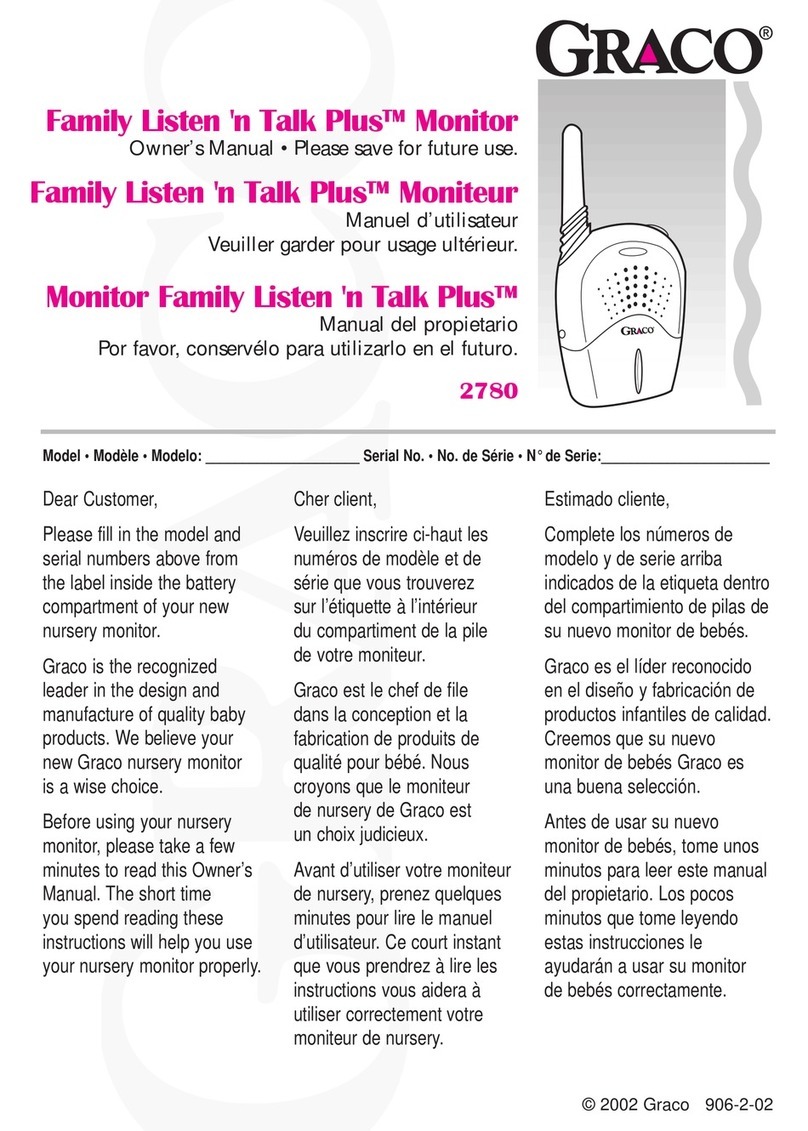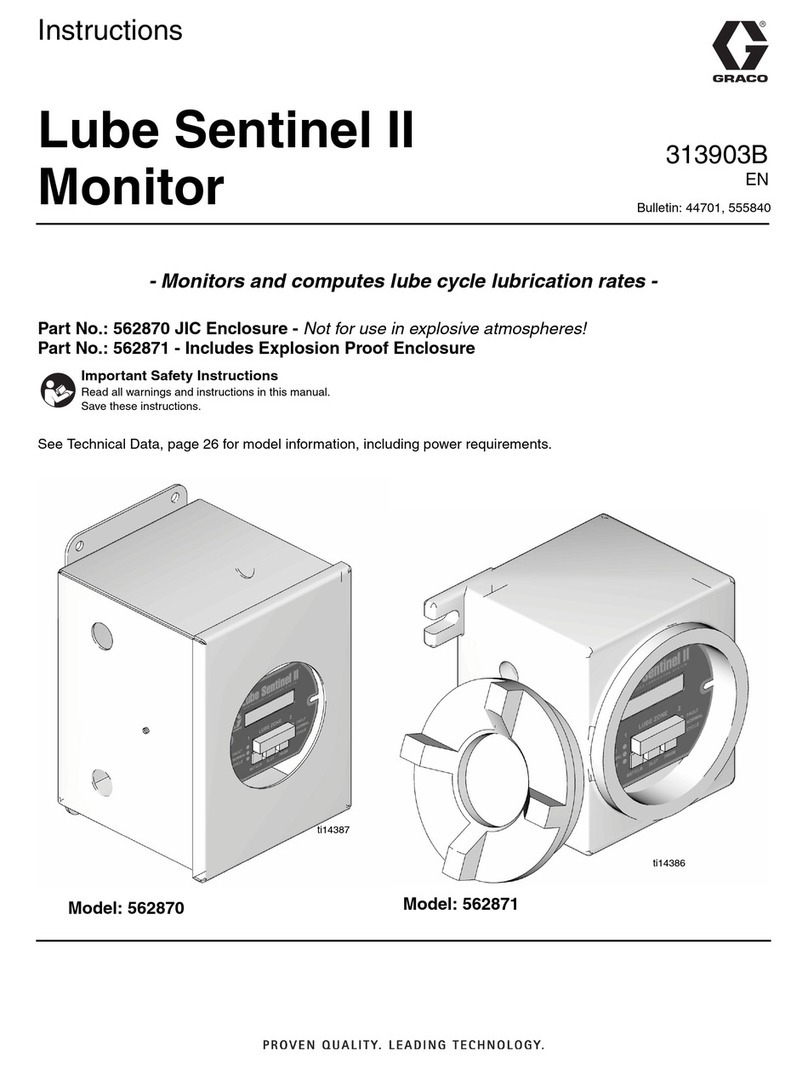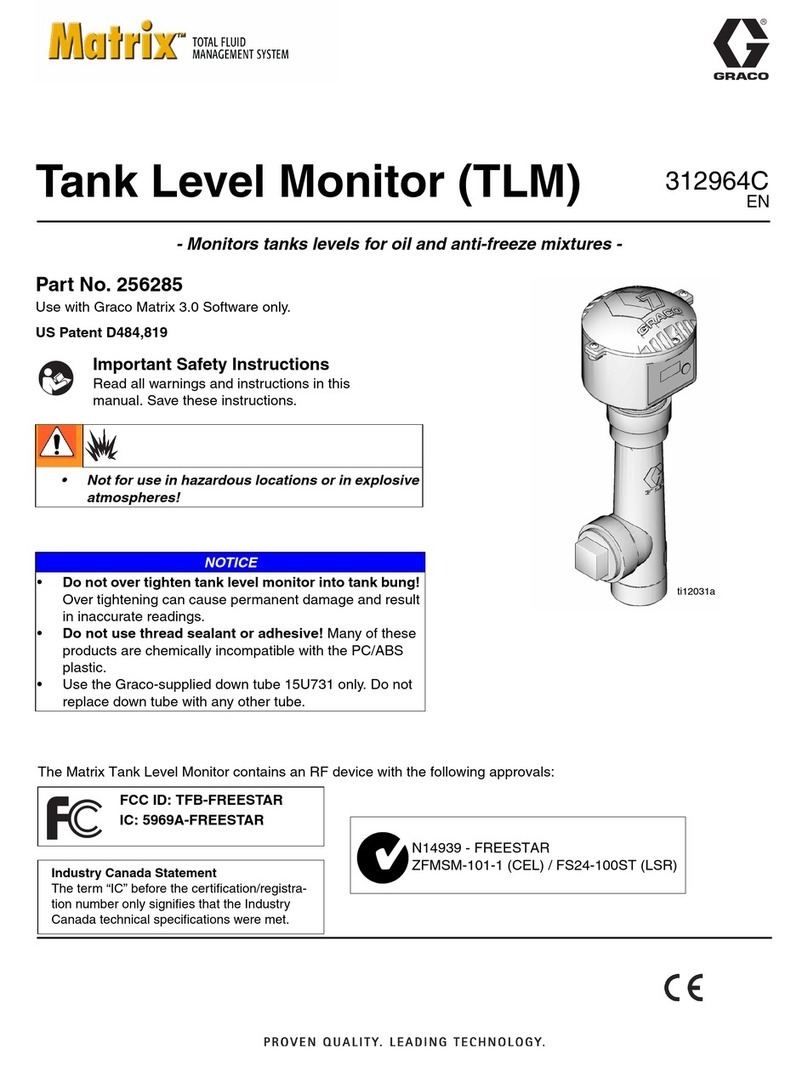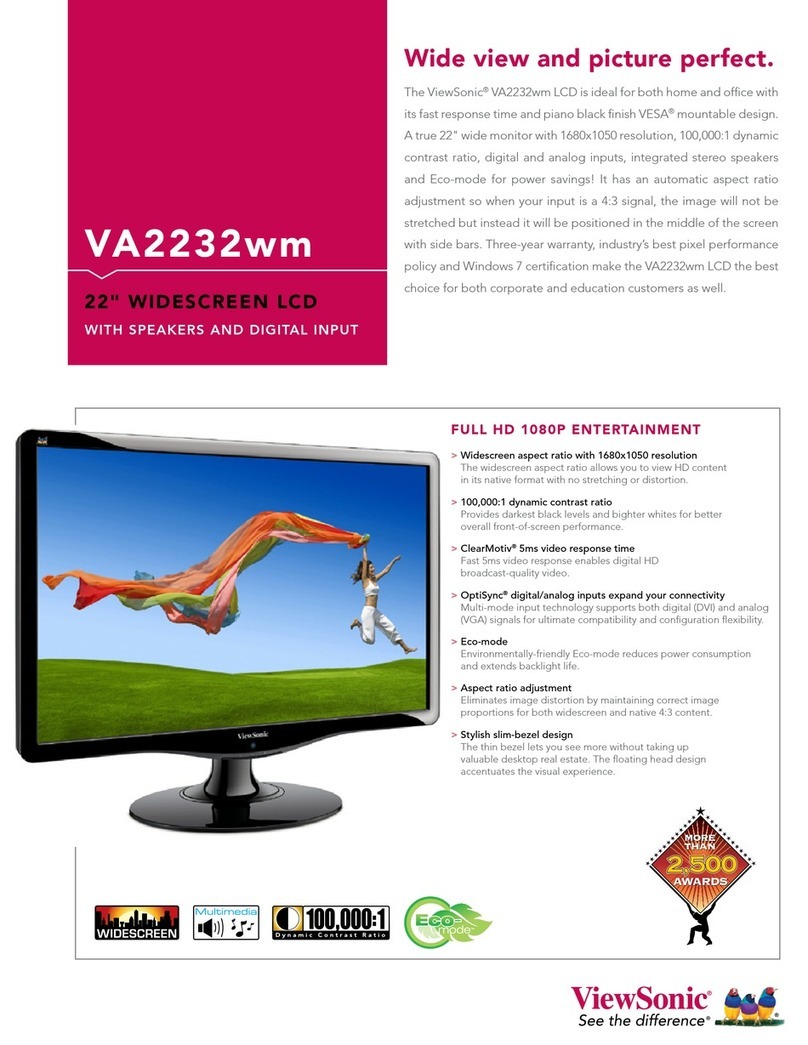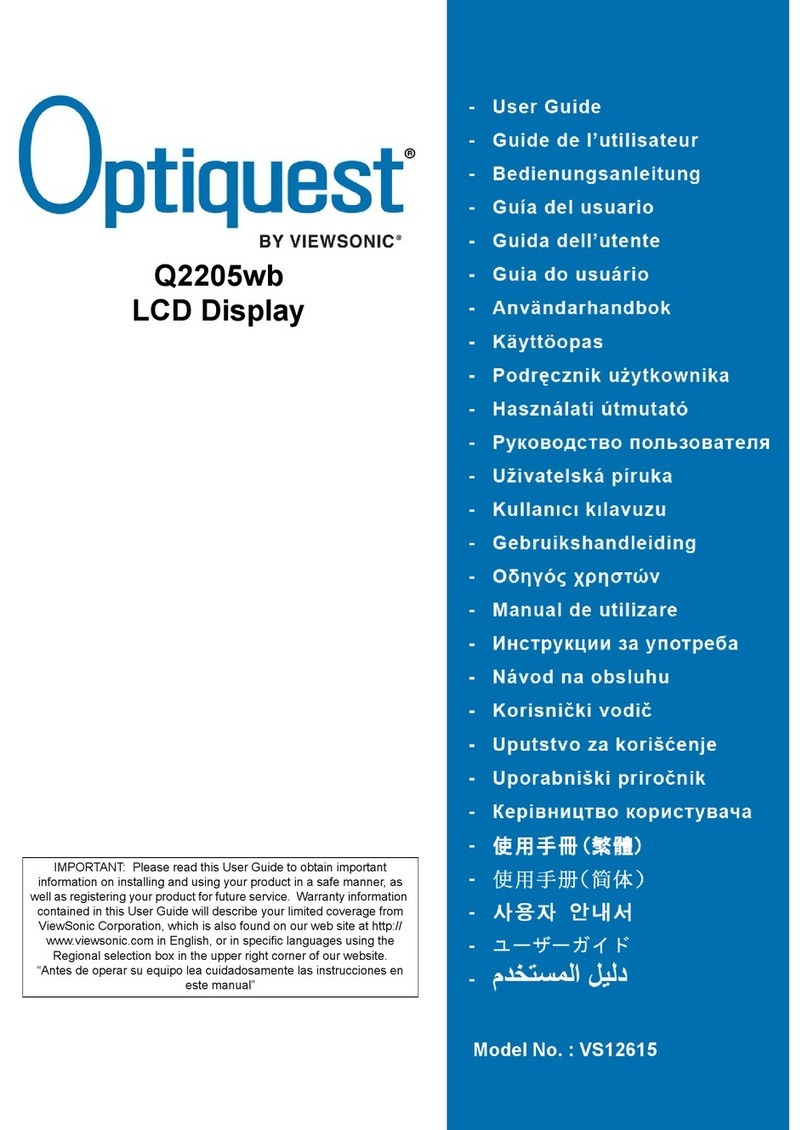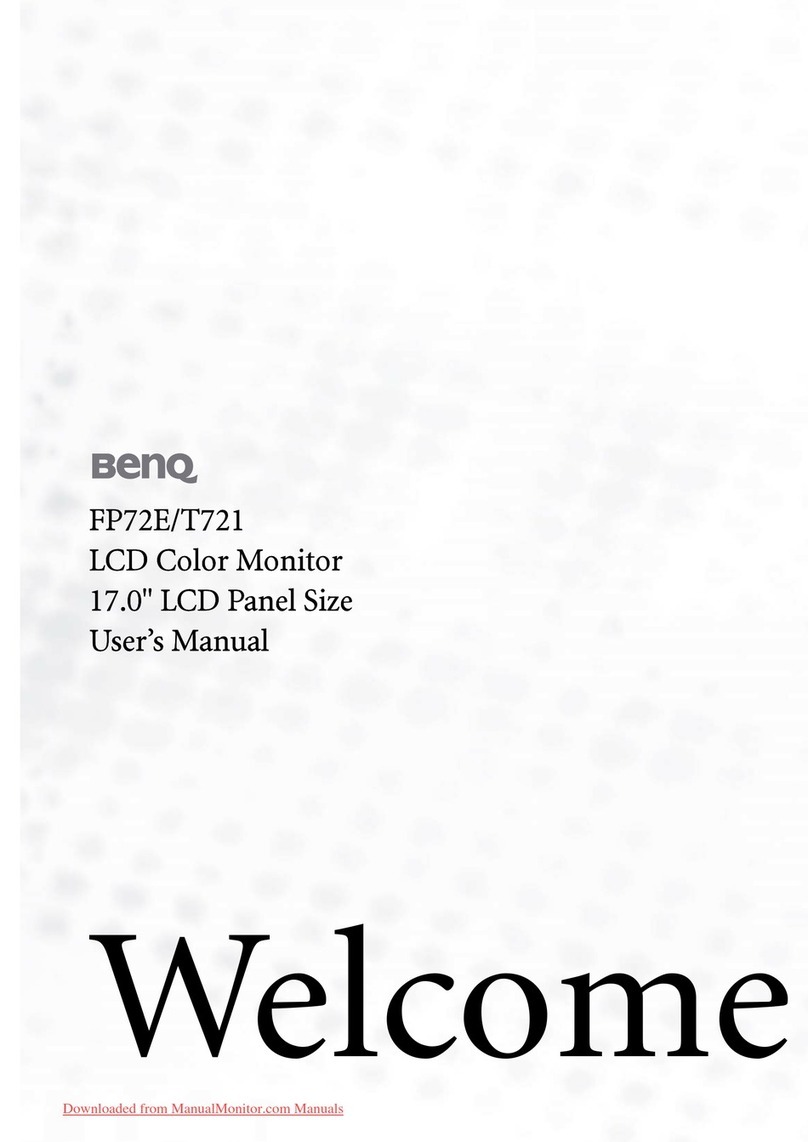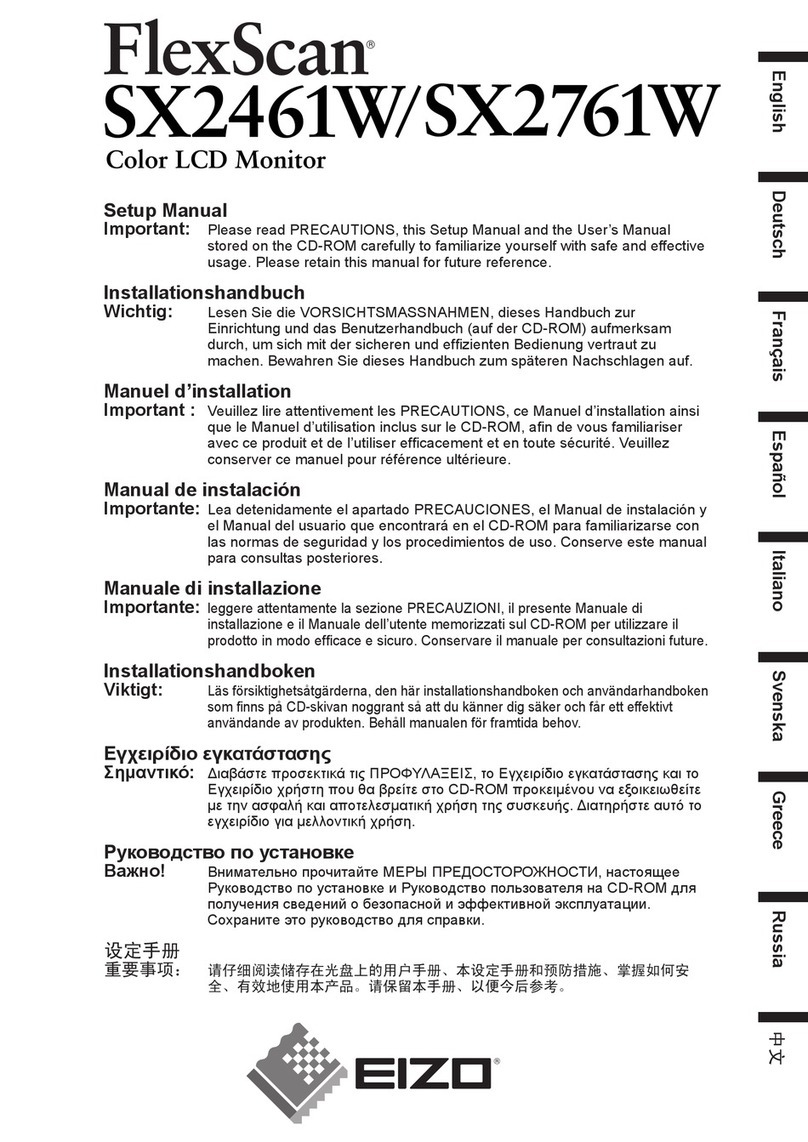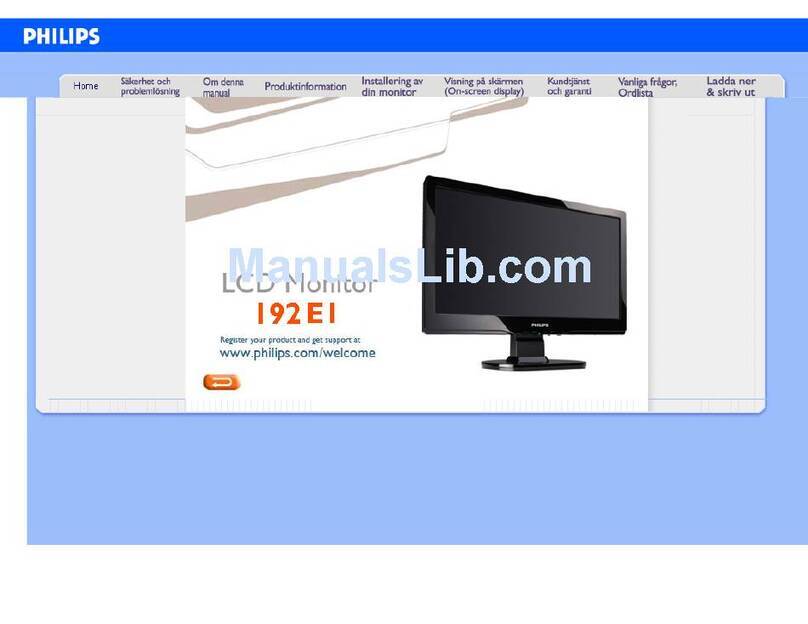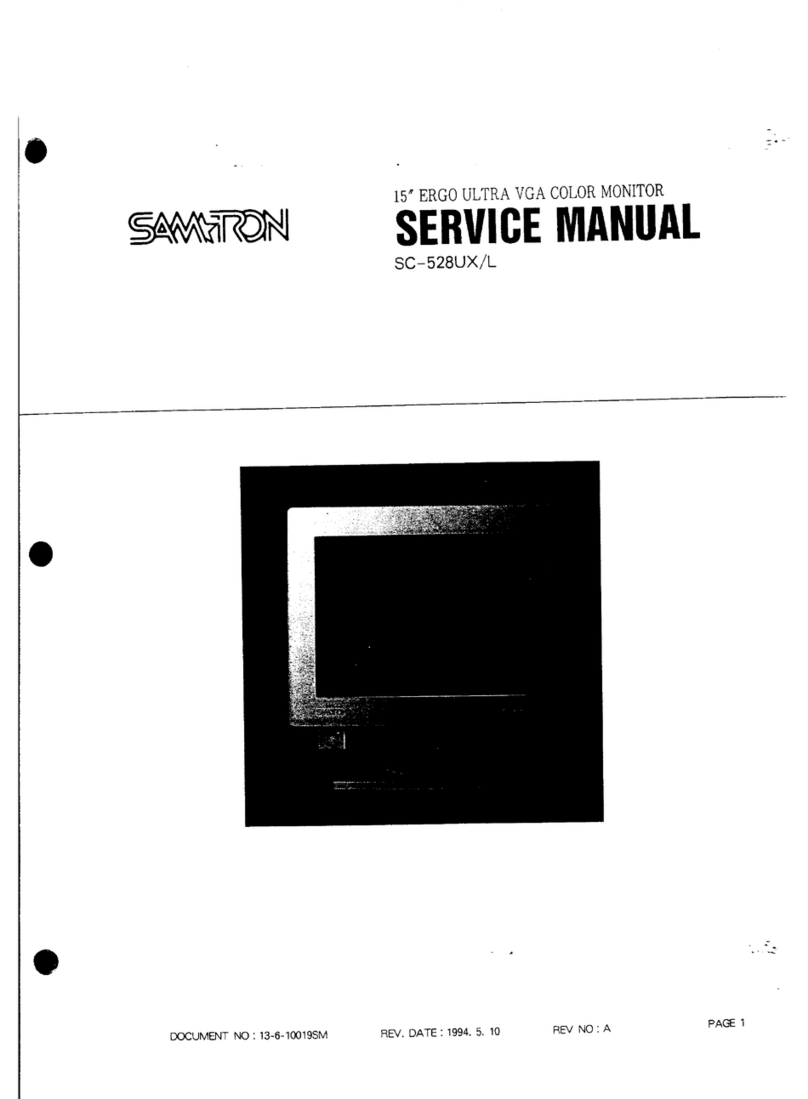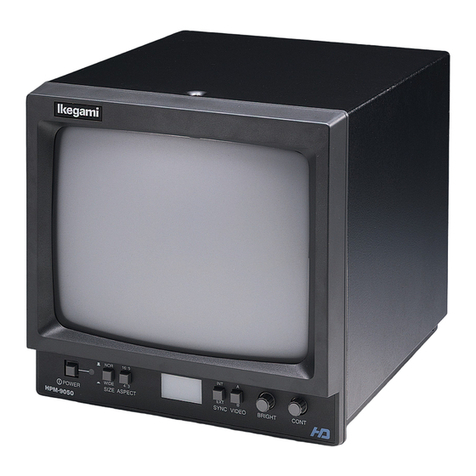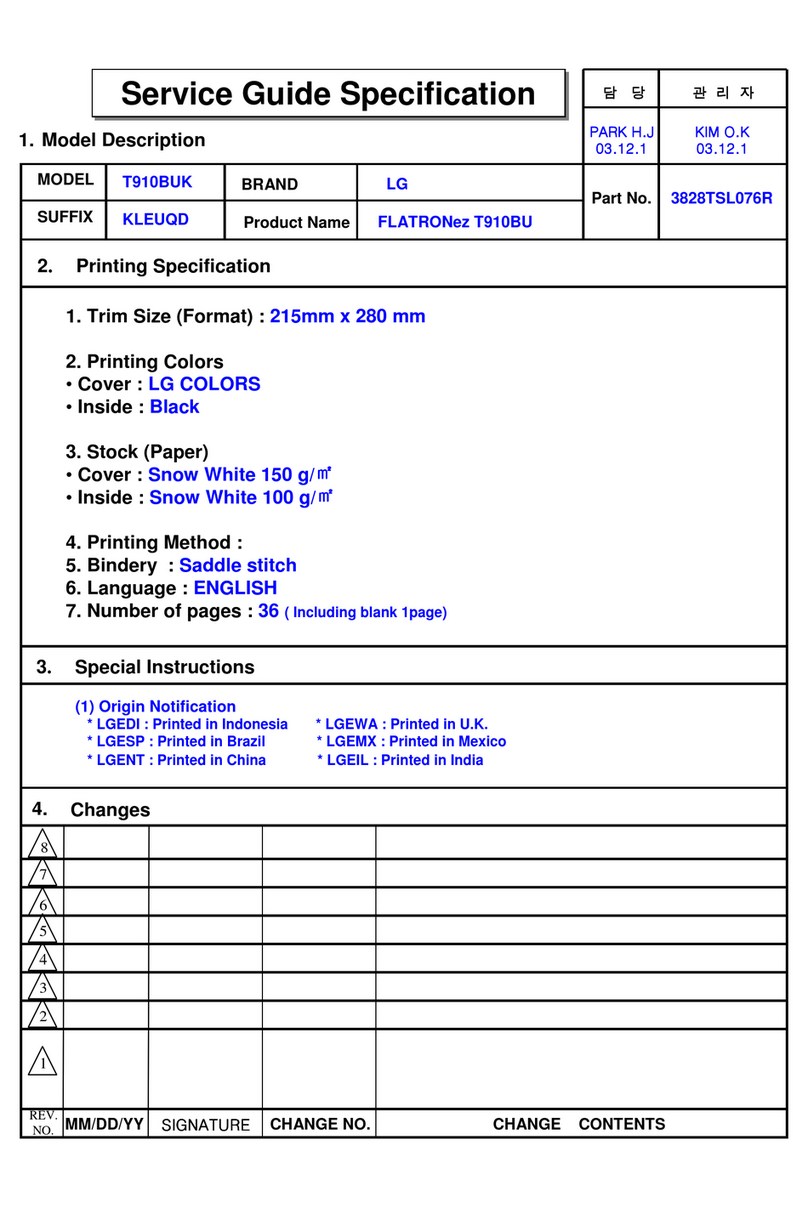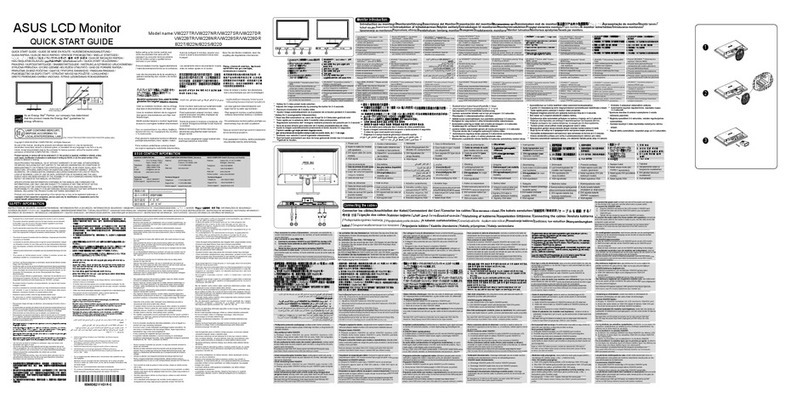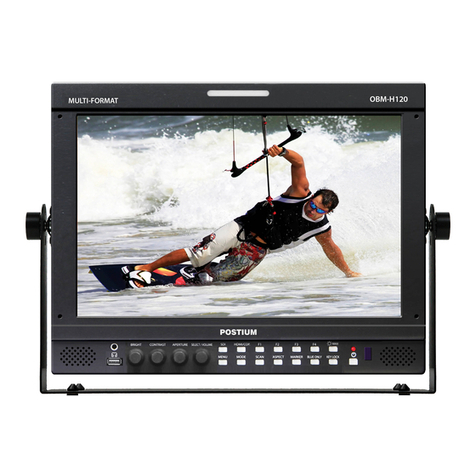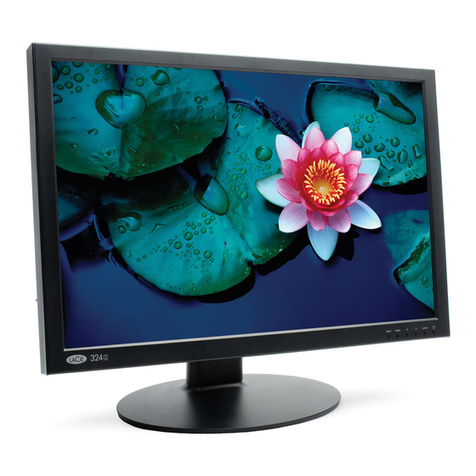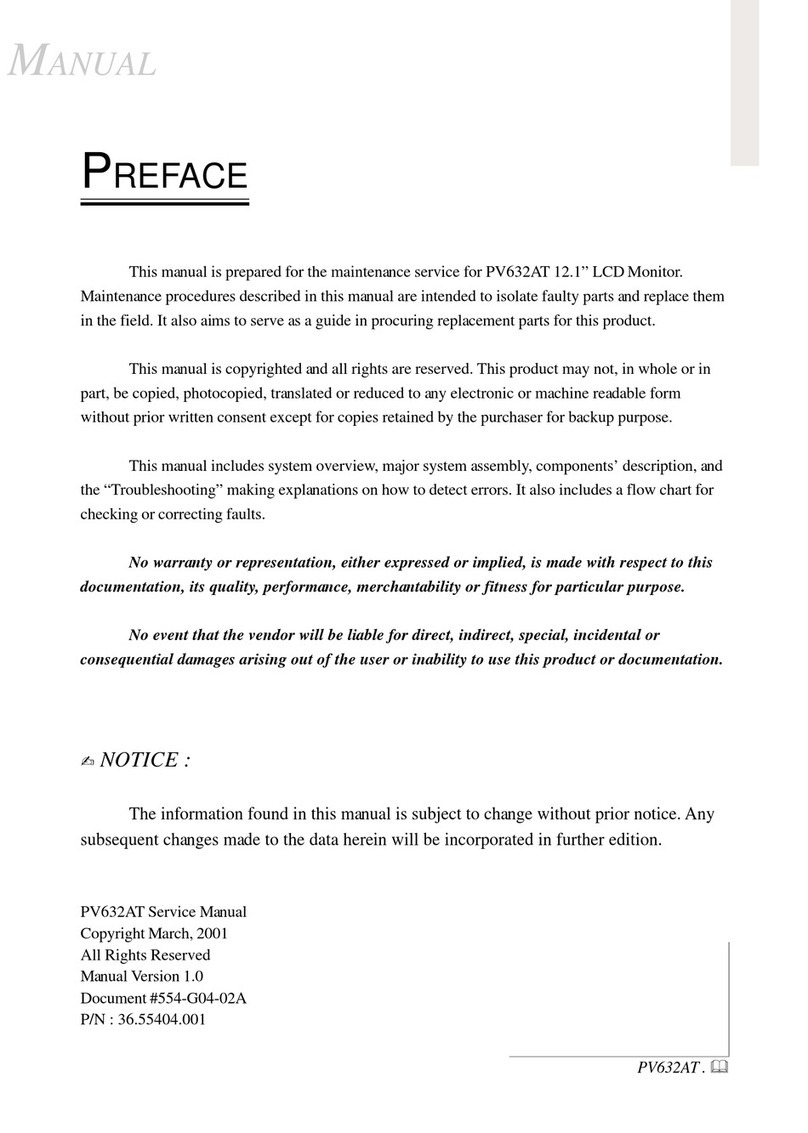Graco Pneumatic PR70 User manual

313937A
Instructions
Pneumatic PR70
For accurate metering, mixing, and dispensing of two-component materials.
SN8050
3000 psi (21 MPa, 207 bar) Maximum Working Pressure
100 psi (0.7 MPa, 7 bar) Maximum Air Inlet Pressure
Important Safety Instructions
Read all warnings and instructions in all sup-
plied manuals. Save these instructions.
Dispense Valve not shown

Related Manuals
2313937A
Contents
Related Manuals . . . . . . . . . . . . . . . . . . . . . . . . . . . 2
Warnings . . . . . . . . . . . . . . . . . . . . . . . . . . . . . . . . . 3
Component Identification . . . . . . . . . . . . . . . . . . . . 5
Grounding . . . . . . . . . . . . . . . . . . . . . . . . . . . . . . . . 6
Installation . . . . . . . . . . . . . . . . . . . . . . . . . . . . . . . . 8
Machine Installation . . . . . . . . . . . . . . . . . . . . . . 8
Initial Startup . . . . . . . . . . . . . . . . . . . . . . . . . . . . . . 9
Startup . . . . . . . . . . . . . . . . . . . . . . . . . . . . . . . . . . 10
Setup . . . . . . . . . . . . . . . . . . . . . . . . . . . . . . . . . . . . 11
Adjusting the Shot Size . . . . . . . . . . . . . . . . . . . 11
Adjust the Dispense Valve Switch . . . . . . . . . . . 11
Dry Run . . . . . . . . . . . . . . . . . . . . . . . . . . . . . . . 12
Prime the Dispense Head . . . . . . . . . . . . . . . . . 12
Phasing Adjustment . . . . . . . . . . . . . . . . . . . . . 13
Adjust Dispense Valve Snuff Back . . . . . . . . . . 14
Ratio Check . . . . . . . . . . . . . . . . . . . . . . . . . . . . 15
Pressure Relief
Procedure . . . . . . . . . . . . . . . . . . . . . . . . . . . . 16
Shutdown . . . . . . . . . . . . . . . . . . . . . . . . . . . . . . . . 16
Maintenance . . . . . . . . . . . . . . . . . . . . . . . . . . . . . . 17
Schedule . . . . . . . . . . . . . . . . . . . . . . . . . . . . . . 17
Clean the Pump Shafts . . . . . . . . . . . . . . . . . . . 17
Disassemble and Clean the Dispense Head . . . 17
Troubleshooting . . . . . . . . . . . . . . . . . . . . . . . . . . . 18
Repair . . . . . . . . . . . . . . . . . . . . . . . . . . . . . . . . . . . 20
HydraCheck Kit Installation . . . . . . . . . . . . . . . . 20
Air Cylinder Kit Installation . . . . . . . . . . . . . . . . . 22
Rear Pump Rebuild Kit Installation . . . . . . . . . . 24
Piston/Cylinder Replacement Kit Installation . . . 26
Check Valve Rebuild Kit Installation . . . . . . . . . 27
Piston Plug Installation . . . . . . . . . . . . . . . . . . . 28
Kits . . . . . . . . . . . . . . . . . . . . . . . . . . . . . . . . . . . . . 29
Dimensions . . . . . . . . . . . . . . . . . . . . . . . . . . . . . . . 31
Technical Data . . . . . . . . . . . . . . . . . . . . . . . . . . . . 33
Graco Ohio Standard Warranty . . . . . . . . . . . . . . 34
Graco Ohio Information . . . . . . . . . . . . . . . . . . . . . 34
Related Manuals
Pneumatic PD44 Manual
Part Description
313904 Pneumatic PD44 Instructions
MD2 Dispense Valve Manual
Part Description
312185 MD2 Dispense Valve Instructions and Parts Manual

Warnings
313937A 3
Warnings
The following warnings are for the setup, use, grounding, maintenance, and repair of this equipment. The exclama-
tion point symbol alerts you to a general warning and the hazard symbol refers to procedure-specific risk. Refer back
to these warnings. Additional, product-specific warnings may be found throughout the body of this manual where
applicable.
For complete warnings, see supplied manuals. See
Related Manuals on page 2.
WARNING
SKIN INJECTION HAZARD
High-pressure fluid from dispense valve, hose leaks, or ruptured components will pierce skin. This may
look like just a cut, but it is a serious injury that can result in amputation. Get immediate surgical
treatment.
• Do not point dispense valve at anyone or at any part of the body.
• Do not put your hand over the end of the dispense nozzle.
• Do not stop or deflect leaks with your hand, body, glove, or rag.
• Follow Pressure Relief Procedure in this manual, when you stop spraying and before cleaning,
checking, or servicing equipment.
TOXIC FLUID OR FUMES HAZARD
Toxic fluids or fumes can cause serious injury or death if splashed in the eyes or on skin, inhaled, or
swallowed.
• Read MSDS’s to know the specific hazards of the fluids you are using.
• Store hazardous fluid in approved containers, and dispose of it according to applicable guidelines.
• Always wear impervious gloves when spraying or cleaning equipment.
PERSONAL PROTECTIVE EQUIPMENT
You must wear appropriate protective equipment when operating, servicing, or when in the operating
area of the equipment to help protect you from serious injury, including eye injury, inhalation of toxic
fumes, burns, and hearing loss. This equipment includes but is not limited to:
• Protective eyewear
• Clothing and respirator as recommended by the fluid and solvent manufacturer
•Gloves
• Hearing protection

Warnings
4313937A
FIRE AND EXPLOSION HAZARD
Flammable fumes, such as solvent and paint fumes, in work area can ignite or explode. To help prevent
fire and explosion:
• Use equipment only in well ventilated area.
• Eliminate all ignition sources; such as pilot lights, cigarettes, portable electric lamps, and plastic
drop cloths (potential static arc).
• Keep work area free of debris, including solvent, rags and gasoline.
• Do not plug or unplug power cords or turn lights on or off when flammable fumes are present.
• Ground all equipment in the work area. See Grounding instructions.
• If there is static sparking or you feel a shock, stop operation immediately. Do not use equipment
until you identify and correct the problem.
• Keep a working fire extinguisher in the work area.
EQUIPMENT MISUSE HAZARD
Misuse can cause death or serious injury.
• Do not operate the unit when fatigued or under the influence of drugs or alcohol.
• Do not exceed the maximum working pressure or temperature rating of the lowest rated system
component. See Technical Data in all equipment manuals.
• Use fluids and solvents that are compatible with equipment wetted parts. See Technical Data in all
equipment manuals. Read fluid and solvent manufacturer’s warnings. For complete information
about your material, request MSDS forms from distributor or retailer.
• Check equipment daily. Repair or replace worn or damaged parts immediately with genuine manu-
facturer’s replacement parts only.
• Do not alter or modify equipment.
• Use equipment only for its intended purpose. Call your distributor for information.
• Route hoses and cables away from traffic areas, sharp edges, moving parts, and hot surfaces.
• Do not kink or over bend hoses or use hoses to pull equipment.
• Keep children and animals away from work area.
• Comply with all applicable safety regulations.
MOVING PARTS HAZARD
Moving parts can pinch or amputate fingers and other body parts.
• Keep clear of moving parts.
• Do not operate equipment with protective guards or covers removed.
• Pressurized equipment can start without warning. Before checking, moving, or servicing equipment,
follow the Pressure Relief Procedure in this manual. Disconnect power or air supply.
WARNING

Component Identification
313937A 5
Component Identification
FIG. 1
101
Key:
101 Tanks
102 System Air Pressure Regulator
103 System Air Pressure Relief Switch
104 Water Separator
105 Air Inlet
106 Shield Locking Screws
107 Machine Shield
108 Agitator
109 Tank Stand
110 Footswitch
108
110
103
108
101
102
110
105 104
103
106
106
101
107

Grounding
6313937A
Grounding
The equipment must be grounded. Grounding reduces
the risk of static and electric shock by providing an
escape wire for the electrical current due to static build
up or in the event of a short circuit.
Tanks: use a ground wire to ground each tank to PR70
base
Footswitch: use a ground wire to ground the footswitch
to the PR70 base.
Spray gun/dispense valve: ground through connection
to a properly grounded fluid hose and pump.
PR70 Base: use a ground wire and clamp. Loosen the
grounding lug locknut and washer. Insert one end of a
1.5 mm2(12 ga) minimum ground wire into the slot in
lug and tighten the locknut securely. Connect the other
end of the wire to a true earth ground. Order part
237569 Ground Wire and Clamp.
Air and fluid hoses: use only electrically conductive
hoses.
Air compressor: follow manufacturer's recommenda-
tions.
Fluid supply container: follow your local code.
Object being sprayed: follow your local code.
Solvent pails used when flushing: follow local code.
use only conductive metal pails, placed on a grounded
surface. Do not place the pail on a non-conductive sur-
face, such as paper or cardboard, which interrupts
grounding continuity.
To maintain grounding continuity when flushing or
relieving pressure: hold metal part of the spray
gun/dispense valve firmly to the side of a grounded
metal pail, then trigger the gun/valve.
See Grounding illustration, FIG. 3 on page 8.

Grounding
313937A 7
FIG. 2: Grounding Illustration
Ground Each
Tank to Base
Use Conductive Hoses to
Ground Dispense Valve
Ground
Footswitch to
Base
A

Installation
8313937A
Installation
Machine Installation
Locate Machine
1. Locate a bench top or open floor area to mechani-
cally mount the machine. Ensure the location has
access to compressed air and AC power and is well
ventilated.
2. Place the machine on the designated location. Allow
the machine to rest on the rubber feet provided.
Mount Machine, if Needed
3. Remove the shield locking screws (110) on both
sides then remove the protective shield.
4. Attach the frame to the selected location by install-
ing fasteners (not provided with unit) through the
four mounting holes. See FIG. 3.
Connect Pressurized Air Input
5. Connect a compressed airline to the air inlet (109)
in the back of the machine.
Avoid contact with electrical inter-connects when
connecting electric power to the machine. Avoid con-
tact with Krytox on the pump shaft, PE tank lid, and
PE tank lid gasket. Contact with Krytox causes
flu-like symptoms. Read all manufacturer’s warning
and material MSDS to know the specific hazards of
the material used.
CAUTION
Do not lift the machine by the tanks.
FIG. 3: Mounting Holes
ti12713a

Initial Startup
313937A 9
Initial Startup
1. Go through the Pre-Operation Checklist in the fol-
lowing table.
2. Turn all switches to RETRACT or OFF.
3. Close all ball valves. Close all other valves within
feed systems.
4. Connect a 3/8 in. or larger diameter air supply line to
the air inlet. This should deliver a minimum 1 cfm at
80 psi for the machine to cycle 10 times per minute,
or 3 cfm at 80 psi for the machine to cycle 30 times
per minute.
5. Connect material hoses to the proper pump outlets.
Secure remaining ends at the dispense valve.
6. Connect the power supply.
7. Increase the air pressure to 30 psi, then reduce it to
0 psi. This will ensure that the air pressure regula-
tors working properly.
8. Connect and tighten all feed mechanism fittings.
Due to packing convenience, some on-site reas-
sembly may be required.
✔Checklist
System Grounded
Verify all grounding connections were made. See
Grounding, page 6.
All connections are tight and correct
Verify all fluid, air, and system connections are
tight and installed according to the supplied sche-
matics.
Air supply valves are open
Verify all Incoming Air Ball Valves are open.
Fluid supply valves are open
Verify all Fluid Line Ball Valves are open.
SHOT
PUMP MODE
RETRACT CONT.
AUTO
DV MODE
CLOSE OPEN
STOP
CAUTION
The maximum air input to the machine is 110 psi. If
plant air exceeds 110 psi, use an in-line regulator and
shut-off valve to reduce the air supply pressure.
CAUTION
If your machine is equipped with mild steel and stain-
less steel pump assemblies, make sure the hose fit-
ting material matches the pump material.
The pumps and hoses are color coded at the fac-
tory. When connecting hoses, match the hose col-
ored tape to the pump assembly colored tape for
proper installation.

Startup
10 313937A
Startup
1. Go through the Pre-Operation Checklist in the fol-
lowing table.
2. Slide the system air pressure relief switch (106) up.
It is the yellow tab at the left, rear of the machine.
The hole in the tab should not be showing.
See startup instructions and related warnings in sup-
plied manuals. See Related Manuals on page 2.
✔Checklist
System Grounded
Verify all grounding connections were made. See
Grounding, page 6.
All connections are tight and correct
Verify all fluid, air, and system connections are
tight and installed according to the supplied sche-
matics.
Air supply valves are open
Verify all Incoming Air Ball Valves are open.
Fluid supply valves are open
Verify all Fluid Line Ball Valves are open.

Setup
313937A 11
Setup
Adjusting the Shot Size
The RETRACT proximity switch enables the machine
logic to retract the air cylinder and pumps when tripped.
Follow these instructions to adjust the position of this
switch for your desired shot size.
1. Loosen the knurled knob securing the RETRACT
proximity switch.
2. Unlock the Stroke Adjust lock by sliding the lever to
the left.
3. Turn the Stroke Adjust lock knob until the RETRACT
proximity switch is in the desired position.
4. Lock the Stroke Adjust lock by sliding the lever to
the right.
5. Tighten the RETRACT proximity switch.
Adjust the Dispense Valve
Switch
1. Reduce air pressure to 0 psi.
2. Loosen the knurled knob that secures the dispense
valve proximity switch.
3. Move the dispense valve proximity switch pointer all
the way to the right and initiate a machine cycle.
4. Slowly increase air pressure until the air cylinder
moves forward and stalls. Do not exceed 30 psi.
5. Return pressure to 0 psi.
6. Slide the dispense valve proximity switch pointer
back to the left until the switch is tripped and air is
heard.
7. Continue to slide the dispense valve proximity
switch pointer approximately another 1/16 in. to the
left then secure.
If the RETRACT proximity switch is set to a point
before the openings of the metering tubes, no
material will dispense.
The machine will produce the most accurate ratio if
the shot size is between 15% and 100% of the
maximum shot size. Smaller shot sizes may pro-
duce less accurate ratios.
Stroke Adjust
Dispense Valve
Stroke Adjust
Dispense Valve

Setup
12 313937A
Dry Run
A dry run demonstrates the machine’s controls and dis-
pensing steps. It also verifies that the machine is work-
ing correctly before you load materials.
1. Place emergency stop in the out position.
2. Set all switches to RETRACT or OFF, and close all
ball valves.
3. Close all other valves within feed system.
4. Set PUMP MODE to SHOT.
5. Set the Stroke Adjust proximity switch to full stroke.
See the Adjust the Dispense Valve Switch section
on page 11.
6. Adjust air pressure to 30 psi.
7. Press and hold the start device.
8. Release the start device. Cycling will end.
9. Press and hold the start device.
10. Push the Emergency Stop.
11. Release the start device.
12. Pull the Emergency Stop out to reset.
13. Set Pump Mode to RETRACT.
14. Set Pump Mode to CONT then press and release
the start device. Machine will cycle continuously.
15. Set Pump Mode to RETRACT. Machine will stop in
retracted position.
Prime the Dispense Head
1. Remove static mixer from the dispense head (102) if
installed.
2. Turn snuff-back adjustment knob (103) fully clock-
wise. This will prevent the dispense valve from clos-
ing between priming shots.
3. Use a 4 mm hex key to loosen the screws (102a)
holding the dispense head in place.
4. Rotate dispense head (102) so the tip is above the
fluid input hoses.
5. Use a 4 mm hex key to tighten screws (102a) hold-
ing dispense head in place.
6. Route the fluid hoses connected to the dispense
head so they are always below the dispense head.
There will be a short delay after power is reapplied
and before the air cylinder and pumps retract.
SHOT
PUMP MODE
RETRACT CONT.
AUTO
DV MODE
CLOSE OPEN
STOP
If the machine is in the middle of a cycle, it will
retract immediately without completing the cycle.
CAUTION
If the dispense head is not primed, chemical cross-
over may occur resulting in cured material in the dis-
pense head, hoses, and/or pumps.
See FIG. 4.
FIG. 4: Prime Dispense Head
102
ti12391a
102a

Setup
313937A 13
This ensures any air in the hoses will travel to the
dispense head.
7. Set the Stroke Adjust switch to the 2 in. mark.
8. Hold a waste container at the end of the dispense
head (102) then press and release the start device.
9. Repeat the previous step until no air comes out of
the dispense valve.
10. If phasing adjustments and ratio checking are not
required, use the following procedure to attach the
static mixer.
a. Attach the static mixer with the dispense head
pointed up.
b. Hold waste container at end of dispense
head (102) then press and release the start
device.
c. Repeat the previous steps until static mixer has
been purged of air.
11. Use a 4 mm hex key to loosen screws (102a) hold-
ing dispense head in place.
12. Rotate dispense head back to normal dispensing
position.
13. Use a 4 mm hex key to tighten the screws (102a)
holding the dispense head in place.
14. Adjust snuff back to proper setting for operation.
See Adjust Dispense Valve Snuff Back on
page 14.
Phasing Adjustment
When the machine executes a shot, materials from
Tank A and Tank B enter the static mixer where they are
mixed and then dispensed. In order for the materials to
mix at the desired ratio, both materials must enter the
static mixer at the same time. The timing of the materials
entering the static mixer is dependent on the adjustment
of the phase adjustment screw for each piston.
Prepare Machine
1. Place a waste container under the dispense valve to
catch dispensed material.
2. Remove static mixer from dispense valve.
3. Install ratio check nozzle onto dispense valve.
4. If necessary, place a stand under ratio check nozzle
to support waste container close to nozzle.
5. Set middle switch to SHOT and bottom switch to
AUTO.
Adjust Dispense Quantity
6. Press and release the start device to dispense a
very small amount of material.
7. Adjust the stroke if more than a couple drops of
either material was dispensed or if no material was
dispensed from both sides. See the Adjusting the
Shot Size section on page 11.
FIG. 5: Ratio Check Nozzle
Shorten the stroke until just a pulse of material dis-
penses. The pumps are in phase when the material
begins to flow from the nozzle outlets at exactly the
same time.
ti12392a

Setup
14 313937A
Adjust Phasing
8. Watch the dispense valve carefully to observe which
material is dispensed first. Press the start device to
dispense material.
9. If the materials do not exit the dispense valve at the
same time adjust the piston Phase Adjustment
Screw (303) as follows.
• If the A side material exits the dispense nozzle
before the B side material ( ):
a. Use two 13 mm wrenches to break loose
the locking nut (302) from the phase adjust-
ment screw (303) on the B material side.
b. Hold the phase adjustment screw (303) sta-
tionary with a 13 mm wrench.
c. Use a 7 mm wrench to turn the piston
shaft (301) counterclockwise 1/4 turn or
less to move the B piston forward.
• If the B side material exits the dispense nozzle
before the A side material ( ):
a. Use two 13 mm wrenches to break loose
the locking nut (302) from the phase adjust-
ment screw (303) on the A material side.
b. Hold the phase adjustment screw (303) sta-
tionary with a 13 mm wrench.
c. Use a 7 mm wrench to turn the piston
shaft (301) counterclockwise 1/4 turn or
less to move the A piston forward.
10. Hold piston shaft (301) and phase adjustment
screw (303) in place with a 7 mm and 13 mm
wrench and tighten locking nut (302) against phase
adjustment screw with a 13 mm wrench.
11. Watch the dispense valve carefully to observe which
material is dispensed first. Press the device to dis-
pense material. If one material exits the dispense
nozzle before the other, go back to step 9.
12. Adjust shot size to desired operational setting. See
the Adjusting the Shot Size section on page 11.
Adjust Dispense Valve Snuff
Back
At the end of a shot, a small amount of material is drawn
back into the static mixer to prevent extra material from
being dispensed. If too much snuff back occurs air will
enter the static mixer and can travel up into the dispense
valve. If too little snuff back occurs the materials may
drip out of the static mixer and affect dispense quantity.
301
302
303
Key:
301 Piston Shaft
302 Locking Nut
303 Phase Adjustment Screw
ti12389a Ensure the piston shaft and phase adjustment
screw do not rotate while tightening the locking
nut (302) in the following step.

Setup
313937A 15
It is most efficient to adjust the snuff back while material
is dispensing but it can also be adjusted when there is
no air pressure in the system.
1. If a static mixer is not in place, install one then prime
the machine. See Prime the Dispense Head,
page 12.
2. Place a waste container under static mixer.
3. Press the start device.
4. Inspect the tip of the static mixer for dripping mate-
rial or for air bubble traveling up the mixer.
5. Perform another shot and while dispensing adjust
the snuff-back adjustment knob (103) as follows.
• If an air bubble is moving up the mixer, turn
knob clockwise to decrease snuff back.
• If material is hanging from tip of mixer, turn knob
counterclockwise to increase snuff back.
6. Repeat step 5 until snuff back is adjusted as
desired.
Ratio Check
1. Remove mixer and shroud.
2. Cycle the machine several times into a waste con-
tainer to clear and prime.
3. Weight six small empty cups and label as indicated.
4. Set the Stroke Adjust switch. See the Adjusting the
Shot Size section on page 11.
5. Turn Pump Mode to SHOT.
6. Place two cups under nose and cycle machine
once. Repeat twice for remaining cups.
7. Weigh the six cups.
8. Subtract the weight of the empty cups from the
weight of the filled cups to get the weight of the dis-
pensed material.
9. Complete the ratio calculations.
Perform ratio check daily. If machine is used for
more than one shift per day, perform ratio check
once per shift.

Pressure Relief Procedure
16 313937A
Pressure Relief
Procedure
1. Place a waste container below the dispense valve.
2. Turn dispense valve switch to OPEN to relieve
chemical pressure.
3. Turn Pump Mode Switch to RETRACT.
4. Press the system air pressure relief switch (106)
down to stop air supply and to vent air pressure in
the machine. It is the yellow tab at the left, rear of
the machine. The hole in the tab should be visible.
5. If necessary, run a lock through the hole to lock the
tab in place. This prevents the system air pressure
from being inadvertently enabled.
Shutdown
If the machine is to remain idle for an extended period of
time, perform the following steps.
1. Place a waste container below the dispense valve.
2. If installed, remove static mixer from the end of the
dispense valve.
3. Place a container below the dispense valve and
activate a small shot to flush mixed material out of
the valve.
4. Relieve pressure. See Pressure Relief Procedure.
5. With a clean rag and cotton swabs, clean the end of
the dispense valve.
6. Install nightcap on the dispense valve.

Maintenance
313937A 17
Maintenance
Schedule
Clean the Pump Shafts
1. Press down air pressure relief switch at left, rear of
machine.
2. Turn Pump Mode switch to RETRACT.
3. Push piston block to fully retracted position.
Clean both pump shafts with solvent and lubricate with
mesamoll or silicon oil.
Disassemble and Clean the
Dispense Head
1. Relieve pressure. See Pressure Relief Procedure,
page 16.
2. Remove dispense head from machine.
3. Dismantle the dispense head. See MD2 Dispense
Valve manual referenced at the beginning of this
manual.
4. Clean all parts.
5. Lubricate all parts with a thin coat of mesamoll or
silicon oil.
6. Reassemble dispense head. See manual 312185
for details.
7. Reinstall dispense head on machine.
Action Schedule Procedure
Check Water/Air Separator Daily before use 1. Check water/air separator for water.
2. Open valve at base of water/air separator to purge
water.
Check Tanks Daily before use 1. Check material levels and refill as necessary.
2. Verify the material reservoirs are vented properly.
Clean Pump Shafts Daily after shutdown See Clean the Pump Shafts on this page
Clean Dispense Head Daily See Shutdown on page 16.
Disassemble and Clean Dispense
Head
As required See Disassemble and Clean the Dispense Head on
this page

Troubleshooting
18 313937A
Troubleshooting
Problem Cause Solution
Pumping (after satisfactory startup)
Pump stalling and no material being
pumped despite adequate input
pressure
Blocked mixer. Turn oil-air supply and remove hoses
from mixer. Check hoses for flow.
Closed outlet ball valves. Open ball valves.
Blocked check valve. Unlikely to be fully restricted, but
possible. Dismantle, clean, and rein-
stall.
Pumps cycling satisfactorily but total
material output dropped off, or one
pump output legs behind the other.
One pump metering incorrectly. Check both outputs from the hoses.
If pumps are out of phase or if one
pump is not discharging a full shot of
material, see next solution.
Pumps not discharging normal or full
volume
Low material level in reservoirs. Refill reservoirs. Prime pump and
hoses.
Air in material (normally only high
viscosity material)
Reload reservoir with minimum air
entrapment. See “air in hose” solu-
tion.
Piston worn or broken. Remove and inspect suspected pis-
ton. Replace if worn or damaged.
Check valve malfunction. Remove, clean, and reinstall the
check valve.
Pumps not cycling at all or pumps
not completely cycling.
Air circuit failure. See Logic Circuit troubleshooting.
Pumps drawing material back down
from hose.
Check valve stuck open. Remove check valve and clean or
replace.
Material continues to flow stop dis-
pense stroke, or air bubble apparent
at some part of the dispense stroke
each time
Air in hose. Hose not primed cor-
rectly.
Incline hose from check valve to out-
let of the hose. Avoid sags in hose.
Cycle machine until all trapped air is
discharged.
Snuff-back not adjusted properly. Increase or decrease the amount of
snuff-back, as needed.
Air in material entrapped during res-
ervoir refill.
Reload reservoir with minimum air
entrapment. (Ask for technical ser-
vice).
Air in material -- being drawn into
pump from behind check valve.
Remove check valve and fitting in
front of pump. Reinstall with PTFE
tape.
Air in material -- being drawn into
pump through shaft seal area, pump
tube, or shaft seal block o-ring joints.
Tighten shaft seal and if badly worn,
replace. Replace and reinstall
o-rings.
Air in material -- being drawn into
pump through inlet hoses or coupler.
Tighten or seal as necessary.
Severe leaks at pump shaft. Pump shaft seals worn. Remove pump packing assembly
and replace shaft seal set.

Troubleshooting
313937A 19
Logic Circuit
Pumps remain in forward position
and will not return
Proximity switch not sensing the trip
plate. Switch roller position may
need adjusting.
If proximity switch is working prop-
erly, the lamp will illuminate.
Proximity switch faulty. If lamp does not work, adjust the
proximity switch by loosening the
mount screws and adjust to 0.062 in.
from the trip plate.
If the lamp still does not work, con-
tact Technical Service or replace.
4-way air cylinder directional control
valve needs servicing or replace-
ment
If proximity switch does not return
the pumps, check the signal through
to the 4-way valve. If ok, then the
4-way valve may be at fault.
Pumps remain at rest in rear position
and do not move when the machine
is signaled to start.
The Start device Check for incoming and outgoing air
flow. Check that signal comes out of
starting device when machine is sig-
naled to start. If not, starting device
is faulty.
4-way air cylinder directional control
valve needs servicing or replace-
ment
If main input air signal comes from
the starting device, then the 4-way
control valve is not changing over.
Remove and service. (Ask for Tech-
nical Service)
Main signal not coming from rear air
cylinder pilot valve.
Check main air input to this valve. If
ok, then air cylinder valve is suspect
and requires servicing.
Material cured on piston rod. Clean piston rod, and apply mesa-
moll.
Pump air cylinder erratic/will not fin-
ish stroke.
Input air pressure to machine
exceeds 110 psi.
Place air regulator in supply line to
machine.
Motionless Mixer (after satisfactory startup)
Patch or uncured spot in mixed
material
Pumps not starting together (phas-
ing)
See Pumping troubleshooting.
Check phasing.
Ratio off. Perform Ratio Check procedures.
Partially unmixed material through
cycle
Mixer not clean or free Dismantle and clean or replace.
Material leaks past inlet valves of
dispense valve, mixing block, or dis-
pense block
Inlet valve o-ring or seals damaged
or worn.
Replace o-rings or seals.
Problem Cause Solution

Repair
20 313937A
Repair
HydraCheck Kit Installation
Prepare Machine for Kit Installation
1. Set Pump Mode switch to RETRACT.
2. Relieve system pressure. See Pressure Relief Pro-
cedure on page 16.
3. Remove shroud screws.
4. Remove the shroud (107).
Install HydraCheck Shock
5. Install shock absorber through the opening in the
pump sub-assembly with the groove for the snap
ring on the back of the pump assembly. The shock
absorber can be inserted through the front or the
back of the pump sub-assembly.
6. Install shock snap ring (included with shock, not
shown) onto the shock absorber in the groove far-
thest from the pump sub-assembly.
7. Install set screw and torque to 85 in-lb (9.6 N•m).
FIG. 6: HydraCheck Installation - Fixed Ratio Base
100d
100b
420
103
104
ti12436a
See Kits on page 29 for kit numbers.
Be sure that system pressure is relieved and dis-
abled before proceeding.
This manual suits for next models
1
Table of contents
Other Graco Monitor manuals
